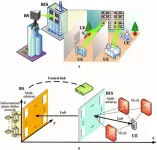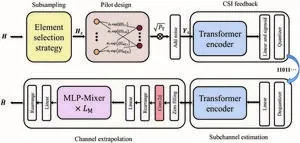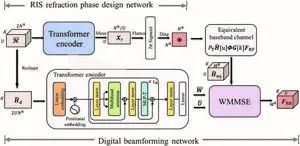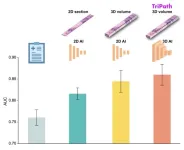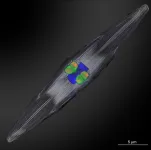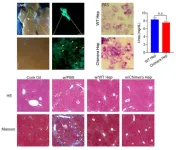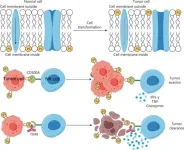Deep learning empowers reconfigurable intelligent surface in terahertz communication
Novel methods for channel extrapolation and beamforming unlocks efficiency and robustness
2024-05-09
(Press-News.org)
The escalating demand for wireless data traffic, driven by the proliferation of internet-of-things devices and broadband multimedia applications, has intensified the search for innovative solutions in wireless communication. A significant breakthrough has been reported in the application of reconfigurable intelligent surfaces for terahertz communications. In a research article published on Mar. 13 in Intelligent Computing, a team of researchers led by Zhen Gao of Beijing Institute of Technology has introduced a novel physical signal processing method that leverages deep learning to enhance the capabilities of reconfigurable intelligent surface in terahertz communication systems.
Reconfigurable intelligent surface is an innovative technology that passively reflects electromagnetic signals in desired directions by adjusting the phase and amplitude of its elements. This ability to dynamically manipulate signals offers significant advantages over traditional communication systems, especially in indoor environments where the complexity of signal propagation can limit performance. This technology can be integrated into current terahertz massive multiple-input multiple-output communication systems to passively reflect electromagnetic signals toward desired direction by manipulating phase and amplitude, thereby offering considerable beam forming gain and addressing the inherent challenges of free-space losses and atmospheric attenuation in the terahertz band.
Acquiring accurate channel state information is critical for communication systems that use reconfigurable intelligent surfaces. While solutions based on compressive sensing and deep learning have been explored, challenges persist in terms of computational complexity and storage requirements. Furthermore, existing studies often assume perfect channel state information, overlooking the practical considerations of imperfect channel state information conditions.
The new transmission architecture based on deep learning, is designed for massive multiple-input multiple-output terahertz communication systems that use reconfigurable intelligent surfaces. Their channel extrapolation method performs channel state information reconstruction better than conventional alternatives while significantly reducing pilot overhead. Moreover, their beamforming method is more robust to imperfect channel state information.
The research introduces two methods:
The SFDCExtra method, a spatial-frequency domain channel extrapolation network method that uses deep learning to extrapolate the complete spatial-frequency channel from limited received pilot signals in communication systems that use reconfigurable intelligent surfaces.
The HBFRPD method, which uses deep learning to design the hybrid beamformer and the refraction phase of the reconfigurable intelligent surface and addresses challenges posed by imperfect channel state information and complex channel characteristics, particularly in indoor scenarios with rich scattering.
The effectiveness of the methods was evaluated through numerical simulations. The SFDCExtra method aims to enhance the efficiency and accuracy of channel estimation in wireless communication systems. By exploiting spatial-frequency correlations, this method offers promising advancements in channel estimation performance while minimizing pilot overhead. The researchers conducted a comprehensive evaluation, comparing it against various benchmark algorithms and assessing its robustness under different channel conditions and pilot configurations. Through detailed analyses and performance comparisons, the method showcases effectiveness and versatility in revolutionizing channel estimation methodologies for next-generation communication architectures.
The researchers compared the performance of HBFRPD with other methods in a multi-user communication system. When testing the sum rates achieved by various methods assuming perfect channel state information, they observed that the method outperforms other methods, especially at higher transmit powers, and offers faster computation due to its noniterative nature. Additionally, with imperfect channel state information, inter-user interference affects the sum rates adversely. The results indicate that HBFRPD remains robust against channel state information errors, outperforming other algorithms in such scenarios. Cumulative distribution functions further support the superior performance, indicating higher probabilities of achieving desired sum rates compared to conventional methods under imperfect channel state information conditions.
END
ELSE PRESS RELEASES FROM THIS DATE:
2024-05-09
Scientists from Trinity College Dublin have made an important breakthrough that offers promise for developing new immune therapies for cancer. They have discovered that a vaccine adjuvant – or “booster” – called C100 promotes potent anti-tumour immunity when it is injected directly into tumours in an animal model.
The scientists found that C100, derived from chitin – one of the most common building materials in nature, and which gives strength to the exoskeletons of crustaceans, insects, and the cell walls of fungi – is highly effective at stimulating a key sensing and signalling molecule which regulates ...
2024-05-09
People with limited English proficiency have a worse experience with virtual healthcare visits than those who are proficient in English, according to a new study led by a team of investigators at Brigham and Women’s Hospital, a founding member of the Mass General Brigham healthcare system. The study highlights the importance of designing telehealth platforms and processes that better serve people who face day-to-day language barriers.
The study, published in JAMA Network Open, analyzed results ...
2024-05-09
About The Study: This cross-sectional study highlights racial and ethnic disparities in treatment declination and overall survival, suggesting the need for equity-focused interventions, such as patient education on treatment benefits and improved patient-clinician communication and shared decision-making, to reduce disparities and improve patient survival.
Corresponding Author: To contact the corresponding author, Dezheng Huo, M.D., Ph.D., email dhuo@bsd.uchicago.edu.
To ...
2024-05-09
About The Study: Residential measures of inequity through segregation, income inequality, or persistent poverty were associated with a greater number of residents living with vision difficulty and blindness in this cross-sectional study. It is essential to understand and address how neighborhood characteristics can impact rates of vision difficulty and blindness.
Corresponding Author: To contact the corresponding author, Patrice M. Hicks, Ph.D., M.P.H., email pmhicks@med.umich.edu.
To access the embargoed study: Visit our For The Media website at this link https://media.jamanetwork.com/
(doi:10.1001/jamaophthalmol.2024.1207)
Editor’s ...
2024-05-09
Researchers developed Tripath to bridge computational gaps to process 3D tissue and predict outcomes based on 3D morphological features
Cancer recurrence models trained on 3D tissue volumes outperformed models trained on 2D tissue images
Human tissue is intricate, complex and, of course, three dimensional. But the thin slices of tissue that pathologists most often use to diagnose disease are two dimensional, offering only a limited glimpse at the tissue’s true complexity. There is a growing push in the field of pathology toward examining tissue in its three-dimensional form. But 3D pathology datasets can contain hundreds of times more data than their 2D counterparts, ...
2024-05-09
New research by the University of East Anglia (UEA) reveals what countries think will be their most difficult to decarbonise sectors when they reach net zero, with agriculture expected to be responsible for the largest remaining emissions.
Once countries have taken the ‘easy’ steps to get to net zero - such as switching to more renewable electricity, electric cars, and heat pumps for homes - they are still left with some sources of emissions.
These ‘residual’ emissions continue to be emitted at the ...
2024-05-09
Nitrogen is an essential component of all living organisms. It is also the key element controlling the growth of crops on land, as well as the microscopic oceanic plants that produce half the oxygen on our planet. Atmospheric nitrogen gas is by far the largest pool of nitrogen, but plants cannot transform it into a usable form. Instead, crop plants like soybeans, peas and alfalfa (collectively known as legumes) have acquired Rhizobial bacterial partners that “fix” atmospheric nitrogen into ammonium. This partnership makes legumes one of the most important ...
2024-05-09
Liver disease, due to viral infections, alcohol abuse, obesity, or cancer, accounts for 1 in every 25 deaths worldwide. A liver transplant can be life saving for people with end-stage liver disease. However, the procedure has limitations related to donor shortage, a technically challenging and invasive surgical procedure, and the requirement for lifelong immunosuppressive medication in the transplant recipients. An alternative to whole organ transplantation is the less invasive injection of dissociated human liver cells, but donor shortage is still an issue. Utilizing ...
2024-05-09
Understanding how fat tissue forms and functions is crucial for addressing obesity and related metabolic diseases. However, adipose tissue, or body fat, behaves differently based on its location in the body.
Take, for example, the omentum: a large, apron-like fatty tissue hanging from the stomach that covers organs within the peritoneum, such as the stomach and intestines. It not only stores fat but also plays roles in immune regulation and tissue regeneration.
Omental adipose tissue is associated with ...
2024-05-09
A new study reveals a groundbreaking approach to immunotherapy, demonstrating that blocking the interaction between the CD300A receptor and phosphatidylserine (PS) significantly enhances the ability of human natural killer (NK) cells to lyse hematologic malignancies (HMs).
Cancer has a profound impact on human life, and immune checkpoint therapy (ICT) has made remarkable strides in cancer treatment. However, ICT faces challenges such as low overall response rates and the emergence of immune-related adverse events. To overcome these hurdles, researchers are exploring new immune checkpoints. CD300A, a type-I transmembrane protein with immunoreceptor tyrosine-based inhibitory ...
LAST 30 PRESS RELEASES:
[Press-News.org] Deep learning empowers reconfigurable intelligent surface in terahertz communication
Novel methods for channel extrapolation and beamforming unlocks efficiency and robustness
